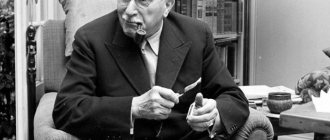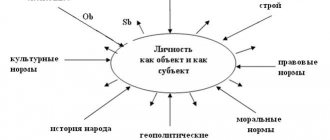In the 20th century, personality theories in psychology developed simultaneously in several directions. And today, the basic concepts and approaches, despite rather contradictory conclusions, allow us to get the most complete picture of a person’s personality.
They provide an opportunity to examine his psyche from different angles. The relativity of these theories can be represented as different projections of one complex and multifaceted subject.
Psychodynamic and analytical theories of personality
Psychodynamic personality theory is a personality theory developed by Z. Fred, according to which the main source of human personality development is his innate biological factors (instincts, libido).
In accordance with S. Freud’s theories of personality, there are three main conceptual blocks, which are the leading authorities of personality:
- ID (“It”) is the basis of the personality structure, consists of a set of unconscious impulses (aggressive and sexual).
- EGO (“I”) is a set of executive and cognitive functions of the psyche that are conscious of a person and consist of his knowledge about the world around him.
- SUPEREGO (“super-ego”) is a structure that includes various social attitudes, norms and values of the society in which a person lives.
Are you an expert in this subject area? We invite you to become the author of the Directory Working Conditions
Analytical theory of personality is a theory of personality developed by C. Jung, who believed that the main source of personality development is its innate psychological factors.
According to this theory, each person inherits primary ideas from his parents, which are called “archetypes.” The meaning of human life is to fill “archetypes” with certain content.
The main conceptual blocks (spheres of personality) in accordance with the analytical theory of personality:
- The individual unconscious is a set of personal feelings and thoughts that are emotionally colored by a person’s consciousness.
- The collective unconscious is the totality of all cultural and historical experience accumulated by humanity during its existence.
- Individual conscious is a structure that acts as the basis of conscious activity and self-awareness of the individual.
Personality structure according to Freud
In Freud's theory of personality, personality structure is depicted as consisting of three areas: the unconscious (Id), the ego, the conscious or self-conscious person (Ego), and the “superconscious” or superconscious person (Super-Ego) [2] (Fig. 26).
According to Freud, the unconscious consists of two basic human instincts: the life instinct and the death instinct. The first encourages a person to preserve and continue life, the second - to put an end to it (destruction)[3]. These two instincts are not realized and not recognized by a person as truly determining his behavior, but they exist and act, nevertheless, forcing a person to constantly seek ways of his complete satisfaction. In realizing these aspirations, a person acts, according to Freud, on the basis of the “pleasure principle.”
However, when a person lives in a modern society among other people, he does not have the opportunity to openly and fully satisfy these instincts, because the living conditions in society, its moral and other norms limit not only satisfaction, but even the open manifestation of these instincts in behavior . A person is raised from childhood to restrain these instincts and eventually learns to do so by learning the rules and norms of cultural behavior in society. The corresponding norms and associated forms of social behavior are also part of his personality, but occupy only its upper part, the “super-ego”. This personality structure regulates a person's behavior based on a "sense of duty and morality."
According to Freud, there is an insoluble conflict between the unconscious and the superego, which gives rise to many intrapersonal problems and conflicts. To a certain extent, a person manages, if not to solve them, then partially or temporarily, through the development and use of psychological defense mechanisms. These are ways to rationally explain and justify human actions that are motivated by instincts, as well as ways to get rid of the feeling of fear that a person may experience due to the awareness that his behavior violates social norms and behaves immorally. Psychological defense mechanisms are part of the third substructure of personality, the “self,” consciousness, or self-awareness. Listed below are some of the psychological defense mechanisms that Freud names and defines in his theory.
- refusal. When reality seems unpleasant to a person, he turns a blind eye to it, tries not to perceive it, denies the existence of the situation or downplays the threat it poses to himself. A common form of this behavior is refusal, denying that criticism is unfair, claiming that what is being criticized does not actually exist. In some cases, denial can play a positive role, for example, when a person is seriously ill and denies this fact (this is how he finds the strength to fight his illness). However, most often, denial prevents people from living and working normally, because, not recognizing the existing danger and refusing fair criticism, they do not take any action to eliminate the danger or correct their own shortcomings.
- suppression. Unlike denial, which in most cases refers to information coming to a person from the outside, repression involves the ego blocking internal impulses that come from the superego and point the person to something unpleasant within himself. In this case, unpleasant experiences and knowledge about oneself that is unacceptable for the individual are, as it were, suppressed from the sphere of his consciousness and do not affect his actual behavior. Most often, thoughts and desires that contradict the moral norms and values accepted by a person are suppressed.
Humanistic and cognitive theories of personality
The humanistic theory of personality is a theory of personality, according to which the main source of personality development is its innate desire for self-actualization.
Finished works on a similar topic
Course work Classification of modern theories of personality 420 ₽ Abstract Classification of modern theories of personality 280 ₽ Test work Classification of modern theories of personality 220 ₽
Receive completed work or specialist advice on your educational project Find out the cost
The humanistic theory of personality is based on two directions: “motivational” (A. Maslow) and “clinical” (K. Rogers).
In accordance with the theories of K. Rogers, the human psyche includes two leading tendencies inherent in nature:
- “self-actualizing tendency” - contains those personality traits that will be developed in the process of life;
- “organismic tracking process” is a mechanism for monitoring the development of a person’s personality.
In accordance with the personality theories of A.G. According to Maslow, personality development is based on the following needs:
- physiological (food, drink, sleep, etc.);
- safety and security needs;
- the need for a certain social status and belonging;
- self-esteem (competence, self-esteem, dignity);
- needs for self-actualization (beauty, creativity, etc.)
Needs represent a pyramid (from low to high). This pyramid is based on physical needs. Only with the satisfaction of the lower need can the individual experience the next need.
The cognitive theory of personality is a theory of personality developed by J. Kelii, according to which the main source of personality development is the external environment and society around him.
J. Kelia's theory of personality is based on the fact that intellectual processes have a significant impact on human behavior and the development of his personality. A special place is given to cognitive processes that form each person’s own personal structure of perception and understanding of the surrounding world and society.
Erikson's concept of personality development
Erikson believed that the elements of personality and its structure develop gradually in the process of social development and, as a consequence, are the product of such development, the result of the individual’s entire path.
Erikson denies the possibility of individual development of an individual personality, but at the same time, he does not deny individuality as a separate concept. He is convinced that for all subjects there is a common plan for their development and believes that personal development itself lasts throughout the life of the subjects. Along with this, he identifies certain stages of development, each of which solves a specific dilemma.
One of the most important concepts in Erikson's concept is ego identity. He believed that the entire personal development of the subject is aimed at the search for precisely this ego-identity. However, the main emphasis is placed on the period of youth.
“Normative identity crisis” is the main point in the formation of personality in the transitional period of adolescence. The crisis is seen here as a turning point, a critical point of development. During this period, both the increasing potential and vulnerability of adolescents are equally exacerbated. The adolescent personality faces a choice of two alternatives, one of which leads to negative behavior, the other to positive.
According to Erikson, the main task for a subject in youth is to develop a sense of identity, which counterbalances the uncertainty of the personal role of the “I”. During this period, the teenager must answer the questions: “The direction of my future path”, “Who am I?” It is in the search for this very identity that a teenager determines the importance of actions and develops specific evaluative norms for his own and other people’s behavior.
This process is inextricably linked with awareness of one’s own competence and value. One method of solving the identity dilemma is to try on different roles. The main danger, according to Erikson, in the process of identification is the possibility of a blurred “I”, which arises as a result of overwhelming doubts in which direction to direct one’s life path. The next reason for the danger of the self-identification process is the lack of maternal attention. Also, frequent causes of such dangers may be inconsistency in the methods and principles of education among parents, which creates a favorable atmosphere of uncertainty for the child and, as a result, a feeling of mistrust.
Identity according to Erikson is an important condition for the mental health of an individual. If the identity has not developed, then such a person will feel lost, not finding his specific place in society. According to Erikson, identity is a characteristic of personality maturity.
Erikson's main contribution to the concept of development is his theory of the stages of personality development.
The first stage is infancy, corresponding to Freud's stage of oral fixation. The main thing during this period is to develop trust and confidence. The formation of trust in society depends entirely on the mother’s ability to convey to the child a sense of constancy of experiences and recognition.
The next stage is autonomy. The child is trying to “get back on his feet” and distance himself from the caregivers. The baby begins to say “no.” If parents try to support his manifestations of independence and protect him from negative experiences, then a healthy imagination, the ability to restrain himself and make concessions to his body are formed. The main task of this period lies in developing a balance between restrictions and what is permitted, acquiring the skills of self-control and independence.
The next stage is initiative. At this stage, the attitude “I am what I will” appears and the attitude “I am what I can” is developed. During this period, the child tries to actively understand the world that surrounds him. With the help of the game, he models various social roles and acquires responsibilities and new tasks. The main thing at this stage is the development of initiative. Gender identification also occurs.
Fourth stage. At this stage, qualities such as hard work or inferiority may develop. The child learns everything that can make it easier and prepare him for adult life (for example, determination).
The fifth stage (from 6 to 11 years) is school age. Identity is formulated in “I am what I have learned.” This period is characterized by the child’s increasing capabilities for self-discipline and logical thinking, the ability to interact with peers, according to established rules. The main question is “Am I capable?”
The next stage is the stage of identity or role confusion (11-18 years old). Characterized by the transition from childhood to adulthood. This period leads to physiological and psychological changes. The basic question is “Who am I?”
The next stage is early adulthood. Questions at this stage address the image of the “I”. Characterized by self-completion and the development of close relationships with other people. The main question is “Can I have intimate relationships?”
The seventh stage is adulthood. Brings a more stable sense of self. Now “I” is expressed in giving in relationships, both at home and at work and in society. A profession and children appeared. Basic questions: “What is the significance of my life today?”, “What will I do next in life?”
The eighth stage is late adulthood or maturity. Characterized by acceptance of one’s role and oneself in life in a deep sense of awareness, understanding of one’s personal dignity. The work is over, there is time for reflection and grandchildren.
The main direction in Erikson's concept of personality development was the consideration of the social adaptation of the individual in the process of his maturation and development.
Domestic psychology
Russian psychology is permeated with the idea of the relationship between man and the world.
Theory of N. A. Berdyaev
According to the concept, the individual cannot be identified with society. Society is part of the individual. The personality itself is an ethical and spiritual category. Each personality contains something common to all people and something different.
There is a degree of mysticism in the perception of personality as something spiritual, but this theory served as the basis for many current provisions about the phenomenon of man as a personality.
The theory of relations by V. N. Myasishchev
According to the concept, a person as an individual is characterized through a system of conscious relationships. The author highlights a person’s attitude to the world of nature and things, people and society, to himself as an individual. At the same time, the system of relations is subordinated to a certain hierarchy, which reflects the significance of the objects of relations for a person.
At the same time, any human relationship is endowed with the following characteristics:
- arises, develops, takes shape and disintegrates in the process of human life;
- always expresses the personality as a whole;
- meaningful (has a subject);
- at a certain level consciously;
- is of a direct or indirect nature (related to a process or place);
- related to needs;
- has three aspects (volitional, cognitive, emotional);
- selectively;
- generalized to varying degrees;
- differs in significance and sustainability.
The author brought relationships with people to the fore.
The development of any relationship, that is, the personality itself, is influenced by upbringing and self-education based on innate characteristics, as well as the social conditions of development and the conscious activity of a person.
Theory of V. S. Merlin
Merlin continued Myasishchev’s theory, but differentiated the concepts of “attitude” and “personal attitude,” or mental properties. In the author’s concept it sounds like this: “Personal properties are only those properties in which personality relationships are expressed.”
The author was one of the first domestic researchers to consider personality as a unity of properties, and not a collection of individual elements. As a result, the psychologist noted the generality, activity and stability of the relationship. These are characteristics that are responsible for exactly how and how quickly the symptom complex (certain interrelated personality properties) changes depending on changes in external conditions.
The author determined that the integrity of the individual depends on the equal development and influence of 3 factors (motives):
- ideological orientation;
- desire for self-expression;
- satisfaction of material needs and organic drives.
This approach is useful in studying the nature of neuroses, character disorders, personality and mental disorders.









